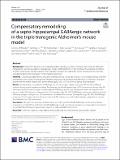Compensatory remodeling of a septo-hippocampal GABAergic network in the triple transgenic Alzheimer’s mouse model
Author(s)
Wander, Connor M.; Li, Ya-Dong; Bao, Hechen; Asrican, Brent; Luo, Yan-Jia; Sullivan, Heather A.; Chao, Tzu-Hao H.; Zhang, Wei-Ting; Chéry, Samantha L.; Tart, Dalton S.; Chen, Ze-Ka; Shih, Yen-Yu I.; Wickersham, Ian R.; Cohen, Todd J.; Song, Juan; ... Show more Show less
Download12967_2023_Article_4078.pdf (4.393Mb)
Publisher with Creative Commons License
Publisher with Creative Commons License
Creative Commons Attribution
Terms of use
Metadata
Show full item recordAbstract
Abstract
Background
Alzheimer’s disease (AD) is characterized by a progressive loss of memory that cannot be efficiently managed by currently available AD therapeutics. So far, most treatments for AD that have the potential to improve memory target neural circuits to protect their integrity. However, the vulnerable neural circuits and their dynamic remodeling during AD progression remain largely undefined.
Methods
Circuit-based approaches, including anterograde and retrograde tracing, slice electrophysiology, and fiber photometry, were used to investigate the dynamic structural and functional remodeling of a GABAergic circuit projected from the medial septum (MS) to the dentate gyrus (DG) in 3xTg-AD mice during AD progression.
Results
We identified a long-distance GABAergic circuit that couples highly connected MS and DG GABAergic neurons during spatial memory encoding. Furthermore, we found hyperactivity of DG interneurons during early AD, which persisted into late AD stages. Interestingly, MS GABAergic projections developed a series of adaptive strategies to combat DG interneuron hyperactivity. During early-stage AD, MS-DG GABAergic projections exhibit increased inhibitory synaptic strength onto DG interneurons to inhibit their activities. During late-stage AD, MS-DG GABAergic projections form higher anatomical connectivity with DG interneurons and exhibit aberrant outgrowth to increase the inhibition onto DG interneurons.
Conclusion
We report the structural and functional remodeling of the MS-DG GABAergic circuit during disease progression in 3xTg-AD mice. Dynamic MS-DG GABAergic circuit remodeling represents a compensatory mechanism to combat DG interneuron hyperactivity induced by reduced GABA transmission.
Date issued
2023-04-15Department
McGovern Institute for Brain Research at MITPublisher
BioMed Central
Citation
Journal of Translational Medicine. 2023 Apr 15;21(1):258
Version: Final published version